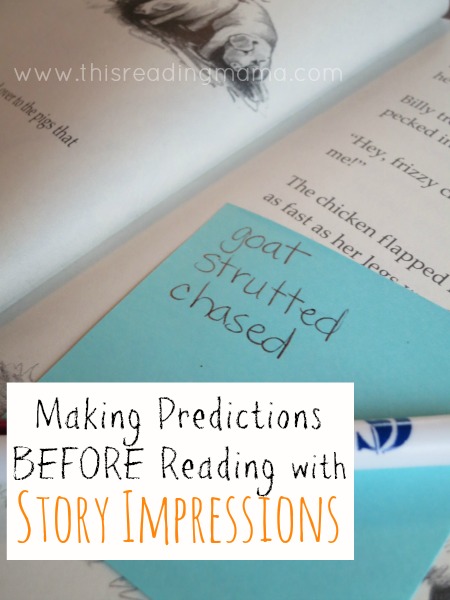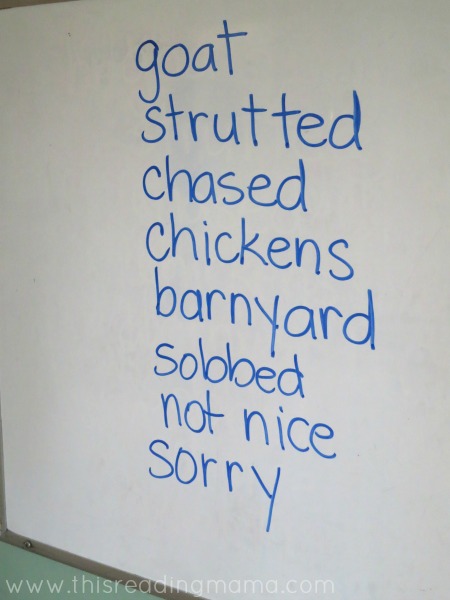This post contains affiliate links. For more information, please read my full disclosure policy.
 Before proficient readers read, they make predictions about the purpose of the text. For example, if I’m looking for a recipe, I know that I will find recipes in a cookbook for that’s the purpose of the text. Proficient readers also make predictions about the content of the text (what will happen, what the subject matter be). I may predict how a certain character will act or think about how the plot will unfold before I read. While proficient readers do these things automatically, most young readers need to be taught.
Before proficient readers read, they make predictions about the purpose of the text. For example, if I’m looking for a recipe, I know that I will find recipes in a cookbook for that’s the purpose of the text. Proficient readers also make predictions about the content of the text (what will happen, what the subject matter be). I may predict how a certain character will act or think about how the plot will unfold before I read. While proficient readers do these things automatically, most young readers need to be taught.
The Importance of Making Predictions Before Reading
Stopping to make predictions together before reading a new text is a great way to help kids think about what they already know about the topic of the book (activates their prior knowledge or schema). Making predictions before reading can also increase the reader’s interest in the book as the reader wants to read to find out if his predictions are accurate or not.
Making Predictions Before Reading with Story Impressions
One simple, yet effective activity to help kids activate their prior knowledge and increase their interest is a story impression. Story impressions work best with fiction narrative texts (stories), but I’m sure they could also be adapted for non-fiction texts as well.
 1- Select words or phrases from the main characters, the settings, and important parts of the action (plot). You don’t want to give away exactly what happens by the words you choose, but you want to pick words that make it possible for the young reader to make a good guess from them. I would suggest picking between 8-15 words, depending on the text length and age of child. Display the words. (We used an All About Reading text from level 3 to do this activity together.) This is also a GREAT way to introduce those vocabulary words before reading!
1- Select words or phrases from the main characters, the settings, and important parts of the action (plot). You don’t want to give away exactly what happens by the words you choose, but you want to pick words that make it possible for the young reader to make a good guess from them. I would suggest picking between 8-15 words, depending on the text length and age of child. Display the words. (We used an All About Reading text from level 3 to do this activity together.) This is also a GREAT way to introduce those vocabulary words before reading!
2- The reader uses the words or phrases from the text to create his own story. The reader’s story serves as a prediction or “guess” as to what will happen in the text. The first couple of times readers do this activity, you will want to guide them to help them see how they can logically connect the words to create a story of their own.
3- Once the oral story has been shared, go to the original text and begin reading to see how close the prediction was to the real story. You may just be surprised at how close your prediction was! I know my son was.
Variations:
- If you are using a chapter book, use this activity with one of the chapters from the book.
- If you are teaching in a group setting, display the list of words to the entire group. Break kids into smaller groups and let them write their stories. Once stories are composed, small groups can read their stories to each other.
If you enjoy these activities and printables, I would encourage you to follow along in one or more of these ways so you don’t miss a thing!
- Subscribe by email
- Google+
- email me: beckythisreadingmama{at}yahoo{dot}com
Thanks, Becky! I have only seen a few of your postings and love your insight and ideas. I am a speech pathologist on a $0 budget. Your ideas make me excited to start some new ways of doing things and provide some fresh activities for my wonderful students. I look forward to reading the rest of your posts and learning from you!
You are very welcome. Isn’t it fun to run across a new idea to add to your tool box? I love it, too.